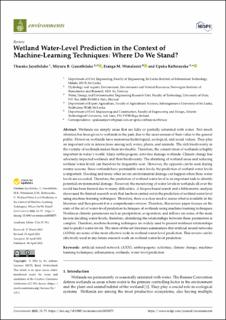| dc.description.abstract | Wetlands are simply areas that are fully or partially saturated with water. Not much attention has been given to wetlands in the past, due to the unawareness of their value to the general public. However, wetlands have numerous hydrological, ecological, and social values. They play an important role in interactions among soil, water, plants, and animals. The rich biodiversity in the vicinity of wetlands makes them invaluable. Therefore, the conservation of wetlands is highly important in today’s world. Many anthropogenic activities damage wetlands. Climate change has adversely impacted wetlands and their biodiversity. The shrinking of wetland areas and reducing wetland water levels can therefore be frequently seen. However, the opposite can be seen during stormy seasons. Since wetlands have permissible water levels, the prediction of wetland water levels is important. Flooding and many other severe environmental damage can happen when these water levels are exceeded. Therefore, the prediction of wetland water level is an important task to identify potential environmental damage. However, the monitoring of water levels in wetlands all over the world has been limited due to many difficulties. A Scopus-based search and a bibliometric analysis showcased the limited research work that has been carried out in the prediction of wetland water level using machine-learning techniques. Therefore, there is a clear need to assess what is available in the literature and then present it in a comprehensive review. Therefore, this review paper focuses on the state of the art of water-level prediction techniques of wetlands using machine-learning techniques. Nonlinear climatic parameters such as precipitation, evaporation, and inflows are some of the main factors deciding water levels; therefore, identifying the relationships between these parameters is complex. Therefore, machine-learning techniques are widely used to present nonlinear relationships and to predict water levels. The state-of-the-art literature summarizes that artificial neural networks (ANNs) are some of the most effective tools in wetland water-level prediction. This review can be effectively used in any future research work on wetland water-level prediction. | en_US |

